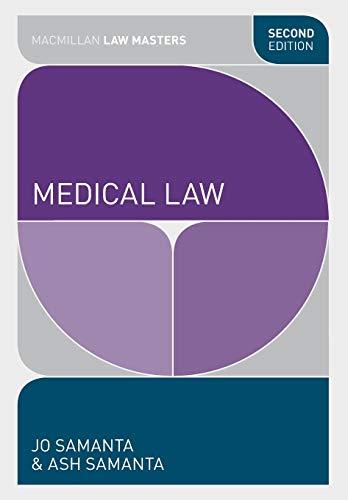Question
The defendant in State v. Cunningham, the owner, and administrator of a residential care facility housed thirty to thirty-seven mentally ill, mentally retarded, and senior
The defendant in State v. Cunningham, the owner, and administrator of a residential care facility housed thirty to thirty-seven mentally ill, mentally retarded, and senior residents. The Iowa Department of Inspections and Appeals conducted various surveys at the defendant's facility between October 1989 and May 1990. All of the surveys except one resulted in a fifty-dollar daily fine assessed against the defendant for violations of the regulations.
On August 16, 1990, a grand jury filed an indictment charging the defendant with several counts of wanton neglect of a resident in violation of the Iowa Code section 726.7 (1989), which provides, "A person commits wanton neglect of a resident of a healthcare facility when the person knowingly acts in a manner likely to be injurious to the physical, mental, or moral welfare of a resident of a healthcare facility. . . . Wanton neglect of a resident of a healthcare facility is a serious misdemeanor."
The district court held that the defendant had knowledge of the dangerous conditions that existed in the healthcare facility but willfully and consciously refused to provide or to exercise adequate supervision to remedy or attempt to remedy the dangerous conditions. The residents were exposed to physical dangers and unhealthy and unsanitary physical conditions and were grossly deprived of the much-needed medical care and personal attention.
The conditions were likely to and did cause injury to the physical and mental well-being of the facility's residents. The defendant was found guilty on five counts of wanton neglect. The district court sentenced the defendant to one year in jail for each of the five counts, to run concurrently. The district court suspended all but two days of the defendant's sentence and ordered him to pay $200 for each count, plus a surcharge and costs, and to perform community service. A motion for a new trial was denied, and the defendant appealed.
The Iowa Court of Appeals held that there was substantial evidence to support a finding that the defendant was responsible for not properly maintaining the nursing facility, which led to prosecution for wanton neglect of the facility's residents. The defendant was found guilty of knowingly acting in a manner likely to be injurious to the physical or mental welfare of the facility's residents by creating, directing, or maintaining hazardous conditions and unsafe practices.
The facility was not properly maintained (for example, findings included broken glass in patients' rooms, excessive hot water in faucets, dried feces on public bathroom walls and grab bars, insufficient towels and linens, cockroaches and worms in the food preparation area, no soap available in the kitchen, and at one point, only one bar of soap and one container of shampoo found in the entire facility). Dietary facilities were unsanitary and inadequate to meet the dietary needs of the residents. There were inadequate staffing patterns and supervision in the facility, and improper dosages of medications were administered to the residents.
The defendant argued that he or she did not "create" the unsafe conditions at the facility. The court of appeals disagreed. The statute does not require that the defendant create the conditions at the facility to sustain a conviction. The defendant was the administrator of the facility and responsible for the conditions that existed.
Please address the following questions
- 1. Analyze this case from the perspective of the four ethical theories presented throughout the courseconsequential ethics, utilitarian ethics, deontological ethics, and nonconsequential ethics.
- 2. Discuss how ethics and the law are intertwined in this case.
- 3. Present your assessment of the court's finding and whether it was just
Step by Step Solution
There are 3 Steps involved in it
Step: 1

Get Instant Access to Expert-Tailored Solutions
See step-by-step solutions with expert insights and AI powered tools for academic success
Step: 2

Step: 3

Ace Your Homework with AI
Get the answers you need in no time with our AI-driven, step-by-step assistance
Get Started


